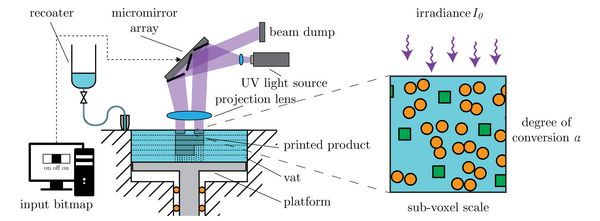Thomas Hafkamp, a Ph.D. researcher at Eindhoven University of Technology, is developing a novel closed-loop control system for additive manufacturing.
Detailed in his thesis titled ‘Towards closed-loop control in photopolymer-based additive manufacturing’, Hafkamp’s work focuses on the resin-based SLA process. The work stems from the fact that most 3D printers today do not utilize sensor data to correct print jobs in real-time, essentially operating on an open-loop whereby the predefined print parameters determine the quality and success of the part.

The power of the feedback loop
While the SLA systems of 2020 are more sophisticated than they’ve ever been, there is still the ongoing issue of print failures. It takes a great deal of skill and experience (and luck) to fabricate a part perfectly on the first run, calling for what is essentially a trial-and-error approach. In the words of Hafkamp, you cannot “CTRL + P and have a defect-free product roll out of the 3D printer”.
Feedback loops, or closed-loops, could be the answer to this, using sensor data and intelligent algorithms to counteract disturbances that would otherwise result in the deterioration of a part’s quality. In the context of SLA, the feedback control would need to address a system’s process models, sensors, and actuators all at once.
Closed-loop control of photopolymerization
Hafkamp’s work starts with a thorough literature review, whereby the researcher demonstrates theoretically that such a control system is possible. However, he determined that the main limitation would be the measurement aspect of the system, as the relevant machine-implementable sensors are not exactly readily available off the shelf. He took it upon himself to design, manufacture, and test a new optical measurement instrument to remedy the problem.
The novel piece of kit is capable of indicating to what extent a vat of photopolymer resin has been cured into its solid state – in other words, a measurement of its cure state. Its measuring principle is based on a molecular absorption photometer operating in the near-infrared (NIR) range and acts as a faster, more cost-effective alternative to similar general-purpose chemical analysis instruments.

As a proof-of-concept, Hafkamp set up an experiment at the TNO Materials Solutions lab comprising an infrared spectrometer, a UV LED actuator, and an embedded controller. The apparatus was complete with his own piece of self-developed software enabling real-time data communication. The results showed that the instrument was capable of taking measurements at a rapid rate of 20,000 per second, paving the way for a more comprehensive, 3D printer-ready real-time control system in the future.

Real-time process monitoring and quality control is an area of active R&D in additive manufacturing. Pennsylvania State University recently received a grant of $180,000 from technology company 3M to explore quality control methods for metal 3D printing. The team will use a nondestructive evaluation (NDE) method, where a part or system is tested without being harmed, to assess parts 3D printed with the binder jetting process.
Elsewhere, Oak Ridge National Laboratory researchers recently developed an AI-based software capable of monitoring the PBF 3D printing process in real-time. Nicknamed Peregrine, the algorithm assesses the quality of parts during production and is a cost-effective alternative to characterization equipment.
Subscribe to the 3D Printing Industry newsletter for the latest news in additive manufacturing. You can also stay connected by following us on Twitter and liking us on Facebook.
Looking for a career in additive manufacturing? Visit 3D Printing Jobs for a selection of roles in the industry.
Featured image shows the NIR measurement instrument. Photo via Eindhoven University of Technology.


